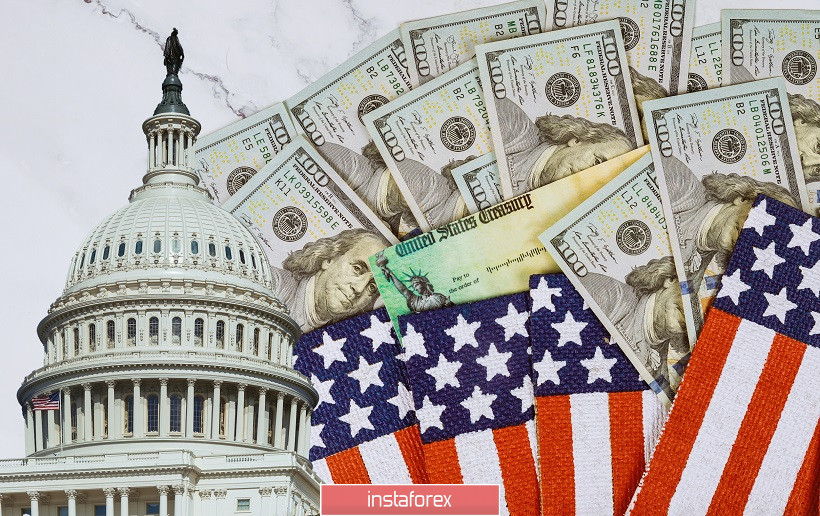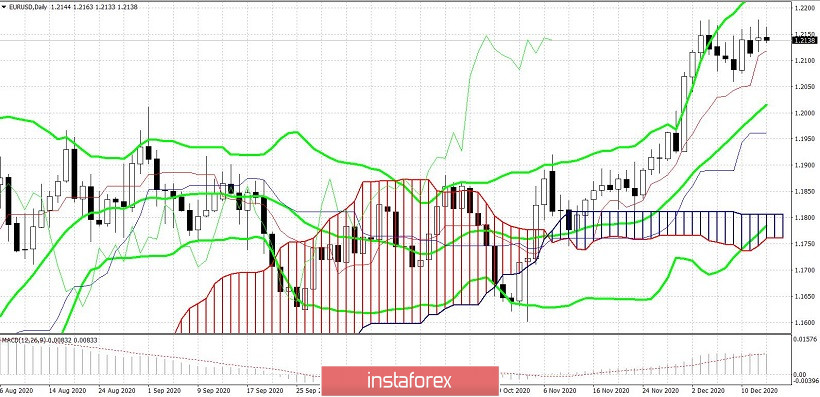The euro-dollar pair is stuck in the area of the 21st figure: Monday's attempts by bulls and bears of EUR/USD to turn the situation in their favor were not successful. Despite the relatively high intraday volatility, the pair ended Monday's trading virtually at the same level as it started from. Traders are waiting for an information impulse that would push EUR/USD out of the flat. Many fundamental factors the market has already played, many factors remain under the sign of uncertainty. In such conditions, it is quite risky to open any positions on the pair, although, in my opinion, the upward trend has still not lost its relevance.
At the Asian trading session on Tuesday, the Electoral College has actually put an end to the presidential election. The results of the vote were not surprising – they were as predicted by the American media over the past few weeks. Joe Biden won 306 electoral votes, against Donald Trump's 232. Now there are formalities: envelopes with the results of the electoral vote will go to the US Congress, where they will be opened on January 6 and the results will be read out. After that, Joe Biden will be officially named the winner of the election.

The market ignored the electoral vote as the result was known in advance. Despite Donald Trump's bellicose statements, he has already been "written off." After the US Supreme Court refused to consider the lawsuit of the Texas attorney to review the election results in four key states (where Biden won by a narrow margin), all of Trump's hopes were finally dashed. Therefore, traders treated Tuesday's vote as a ceremonial formality.
However, news from Capitol Hill can still provoke volatility in the EUR/USD pair. We are talking about congressmen considering a new package of measures to stimulate the US economy. A new bill was introduced to Congress on Tuesday, which (unlike previous ones) has a high chance of becoming law. The fact is that the new draft law is bipartisan, that is, both Democrats and Republicans participated in its development. Many American analysts view this document as the most realistic and promising compromise solution regarding the allocation of aid to combat the consequences of the coronavirus crisis.
Let me remind you that negotiations on a new aid package have been going on since the end of May. For six months, Democrats and Republicans were unable to "bring debit to credit": representatives of the Democratic Party insisted on large-scale aid in the amount of 2-3 trillion dollars, but their opponents were categorically against such "wastefulness." The parties sat down at the negotiating table several times, but each time they could not find a compromise solution.
The turning point in the current stalemate was Joe Biden's victory in the presidential election. In light of new (upcoming) White House appointments, House Democratic leader Nancy Pelosi publicly endorsed the compromise bill over the weekend. According to her, after the inauguration of the newly elected president, a new, larger aid package will be agreed upon.
Thus, the likelihood of accepting a new aid package is quite high. The proposed bill is in two parts. The volume of the first part is almost $750 billion. This part of the document includes an increase in the size of federal unemployment benefits, an increase in funding for education, as well as the allocation of funds for the production and distribution of coronavirus vaccines throughout the country.
The cost of the second part of the bill is $160 billion. Despite the smaller volume, the main political disputes developed around this part of the document. The Democrats are proposing, as part of this package, to allocate additional funds to combat the pandemic to the state authorities, which, accordingly, are opposed by the Republicans. Given the heat of political passions, many experts admit the option of adopting only the first part of the bill.
But in this case, the markets will react, and this reaction will certainly not be in favor of the dollar. Firstly, against the background of the Congress decision, interest in risky assets will again increase: in particular, the stock market will go up, while the demand for a safe greenback will significantly decrease. Secondly, the US Federal Reserve at its December meeting (the results of which we will find out tomorrow) is likely to increase the purchase of long-term Treasury bonds (to curb the growth of yields), and will also voice "dovish" theses regarding the prospects for monetary policy. Such a fundamental background will allow buyers of EUR/USD to approach the borders of the 22nd figure again and test this price area.
At the moment, the pair is showing a correction due to news from Germany - from December 16, a tight lockdown is being introduced there. Retail stores (with the exception of grocery stores) will be closed throughout the country, schools and kindergartens will also be closed. The strict quarantine will last until at least January 10.

In my opinion, the current price decline in the EUR/USD can be used as an excuse to open long positions with the main target in the medium term at 1.2200 (upper line of the Bollinger Bands indicator on the daily chart). On the weekly chart, the price is located on the upper line of this indicator, on the daily chart - between the middle and upper lines. In both cases, the pair is above all the lines of the Ichimoku indicator (including the Kumo cloud), which also indicates the strength of the upward trend.





















